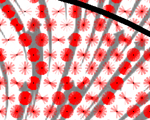Semiotics
Semiotics is the discipline concerned with how symbols convey meaning. Semiotics is mostly concerned with arbitrary symbols, but visual symbols are not arbitrary. To be effective, visual symbols, as used in diagrams and other visualizations must have a good match to the processing mechanisms of the human visual system.
The idea of experimental semiotics is to use perceptual theory combined with rigorous experimental methods to understand scientifically what makes a good representation of data. Ware’s book: Information Visualization: Perception for Design (edition II) is a standard reference work that has helped to define this approach.
In addition to the theoretical approach, we also create optimized and experimentally validatated visualizations for clients such as NOAA. If you need a high quality representation of some data for the web or another purpose, please contact us.
References
-
Ware, C. (2008) Visual Thinking for Design. Morgan Kaufman.
-
Ware, C (2004) Information Visualization: Perception for Design. 2nd Edition. Morgan Kaufman. San Francisco, 485 pages.
-
Pineo, D., and Ware, C. (2010) Neural Modeling of Flow Rendering Effectiveness . ACM Transactions on Applied Perception. 7(3).
-
Ware, C. (2008) Towards a perceptual theory of flow visualization . IEEE Computer Graphics and Applications. 28(2),6-11.
-
Ware, C. and Mitchell, P. (2008) Visualizing Graphs in Three Dimensions . ACM Transactions on Applied Perception. 5(1). 2:1-15.
-
Plumlee M. and Ware, C. (2006) Cognitive costs of zooming versus using multiple windows . ACM Transactions on Applied Perception. 13(2) 1-31.
-
House, D.H., Bair, A. and Ware, C. (2006) An approach to the perceptual optimization of complex visualizations . IEEE Transactions on Visualization and Computer Graphics. 12(4) 509-521.
-
Ware, C., (2006) 3D Contour Perception for Flow Visualization. Proceedings, ACM SIGGRAPH Symposium on Applied Perception in Graphics and Visualization (APGV). 1101-106.
-
Ware, C., and Bobrow, R., (2005) Supporting visual queries on medium sized node-link diagrams . Information Visualization. 4 (1), 49-58.
-
Ware, C., and Bobrow, R. (2004). Motion to support rapid interactive queries on Node-Link diagrams . ACM Transactions on Applied Perception. 1, 1-15.
-
Arsenault, R., and Ware, C. (2004) The Importance of Stereo, Eye Coupled Perspective and Touch for Eye-Hand Coordination . Presence:Teleoperators and Virtual Environments. 13(5), 549-559.
-
Bartram, L., Ware, C. and Calvert, T. (2003) Moticons: Detection, Distraction and Task . International Journal of Human-Computer Studies, special issue on Notifications and Interruptions, 58(5), pp. 515-545.
-
Kosara, R., Healey, C.G., Interrante, V., Laidlaw, D.H., and Ware, C. (2003) Thoughts on User Studies: Why, How and When. IEEE Computer Graphics and Applications. July, 20-25.
-
Ware, C., and Purchase, H., Colpoys L. and McGill, M. (2002) Cognitive Measurements of Graph Aesthetics . Information Visualization. vol 1. 103-110.
-
Laramee, R. and Ware, C. (2002) Rivalry and Interference with a Head Mounted Display . ACM Transactions on CHI. 9(3) 1-14.
-
Ware, C. (2001) Designing with a 2 1/2D Attitude . Information Design Journal. 10(3) 255-262.
-
Ware, C., Bonner, J., Cater, R. and Knight, W., (1992) Simple Animation as a Human Interrupt. International Journal of Human-Computer Interaction. 4(4) 341-348.
-
Ware, C. and Franck, G. (1996) Evaluating Stereo and Motion Cues for Visualizing Information Nets in Three Dimensions . ACM Transactions on Graphics. 15(2) 121-139.
-
Ware, C. and Knight, W. (1995) Using Visual Texture for Information Display. ACM Transactions on Graphics. 14(1) 3-20.
-
Ware, C. (1993) The Foundations of Experimental Semiotics. Journal of Visual Languages and Computing. 4, 91-100.
-
Ware, C., (1988). Color Sequences for Univariate Maps: Theory, Experiments and Principles . IEEE Computer Graphics and Applications. 8(5), 41-49.
-
Ware, C. and Beatty, J.C. (1988). Using Color Dimensions to Display Data Dimensions. Human Factors. 30(2), 127-142.
-
Ware, C., and Bobrow, R. (2006) Motion Coding for Pattern Detection. Proceedings, ACM SIGGRAPH Symposium on Applied Perception in Graphics and Visualization (APGV). 107-110.
-
Ware, C. and Mitchell, P. (2005) Reevaluating Stereo and Motion Cues for Visualizing Graphs in three dimension. Proceedings, ACM SIGGRAPH Symposium on Applied Perception in Graphics and Visualization (APGV). 51-58.
-
Bair, A., House, D., and Ware, C. (2005) Perceptually optimizing textures for layered surfaces. ACM SIGGRAPH Symposium on Applied Perception in Graphics and Visualization (APGV). 67-74.
-
House, D., Bair, A., and Ware, C. (2005) On the Optimization of Visualizations of Complex Phenomena. Proceedings, IEEE Visualization. Minneapolis. 87-94.
-
Ware, C., Gobrecht, C. and Paton, M., (1995) Algorithm for dynamic disparity adjustment. IS&T/SPIE Symposium on Electronic Imaging: Science and Technology, SPIE 2409. 152-159.
-
Ware, C. and Knight, W. (1992) The Orderable Dimensions of Visual texture Useful for Data Display: Orientation, Size and Contrast. CHI'92 Technical paper, Monterey, Proceedings. 203-209 Note: only 65 out of 305 papers accepted.
-
Ware, C. (1986). Choosing a Colour Sequence for Univariate Maps . Proceedings of IEEE Conference on Systems, Man & Cybernetics 1. 41-45. October.
